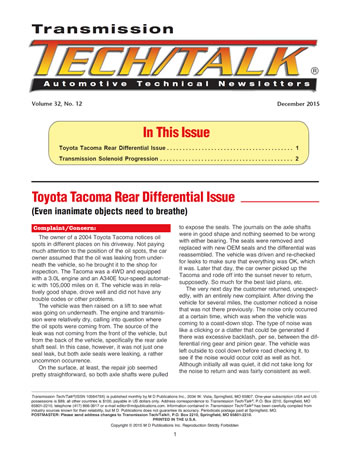



The owner of a 2004 Toyota Tacoma notices oil spots in different places on his driveway. Not paying much attention to the position of the oil spots, the car owner assumed that the oil was leaking from under-neath the vehicle, so he brought it to the shop for inspection. The Tacoma was a 4WD and equipped with a 3.0L engine and an A340E four-speed automatic with 105,000 miles on it. The vehicle was in relatively good shape, drove well and did not have any trouble codes or other problems.
The vehicle was then raised on a lift to see what was going on underneath. The engine and transmission were relatively dry, calling into question where the oil spots were coming from. The source of the leak was not coming from the front of the vehicle, but from the back of the vehicle, specifically the rear axle shaft seal. In this case, however, it was not just one seal leak, but both axle seals were leaking, a rather uncommon occurrence.
On the surface, at least, the repair job seemed pretty straightforward, so both axle shafts were pulled to expose the seals. The journals on the axle shafts were in good shape and nothing seemed to be wrong with either bearing. The seals were removed and replaced with new OEM seals and the differential was reassembled. The vehicle was driven and re-checked for leaks to make sure that everything was OK, which it was. Later that day, the car owner picked up the Tacoma and rode off into the sunset never to return, supposedly. So much for the best laid plans, etc.
The very next day the customer returned, unexpectedly, with an entirely new complaint. After driving the vehicle for several miles, the customer noticed a noise that was not there previously. The noise only occurred at a certain time, which was when the vehicle was coming to a coast-down stop. The type of noise was like a clicking or a clatter that could be generated if there was excessive backlash, per se, between the differential ring gear and pinion gear. The vehicle was left outside to cool down before road checking it, to see if the noise would occur cold as well as hot. Although initially all was quiet, it did not take long for the noise to return and was fairly consistent as well.

Due to the type of noise the concern became, did someone fail to add in the required amount of differential lube, or for that matter any lube? The vehicle was put back on a lift so that the oil level could be checked, which was when something strange happened. As soon as a technician removed the differential fill plug, there was a big sucking sound almost as though a massive vacuum pump had been connected to the differential housing. At that point, a big revelation occurred as to why both differential axle shaft seals chose to start leaking at the same time. There could only be one explanation.

The instant that the technician looked at the vent, which was screwed into the top of the differential housing, everything became clear. Unlike many of the newer truck differential vents, which have a fairly long rubber hose attached, the vent on the Tacoma merely has a metal cap on top of the body, similar to older transmission metal vents, (figures 1a/1b). Whether the car owner occasionally took the truck mud dubbing or backed into a lake while launching a boat, the vent was plugged completely shut regardless.
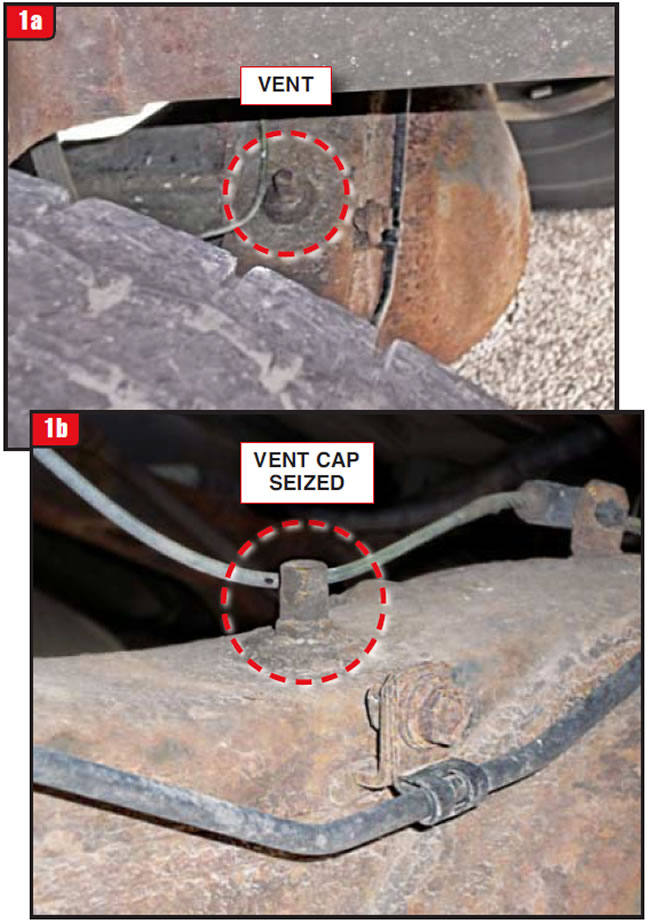
At what point this condition happened is unclear; however, once it did, the axle seals bit the dust and they became the vent. The question then became, after the new seals were installed and the differential was allowed to build up pressure, what impact would that have on the noise that was made? Apparently, the internal pressure had an impact with either how the oil was allowed to splash around the gearing or had some sort of effect on the ring and pinion directly, causing a chattering effect and only on coast down. In any case, the vent assembly was cleaned out and reinstalled, the oil level checked and the vehicle taken for an extremely long test drive. To everyoneʼs surprise, the noise was completely gone. Chalk up another scenario to Ripleyʼs believe it or not. If needed, the differential vent design is similar to certain transmission vents, such as a Toyota A130/A140 cover vent (Figure 2).
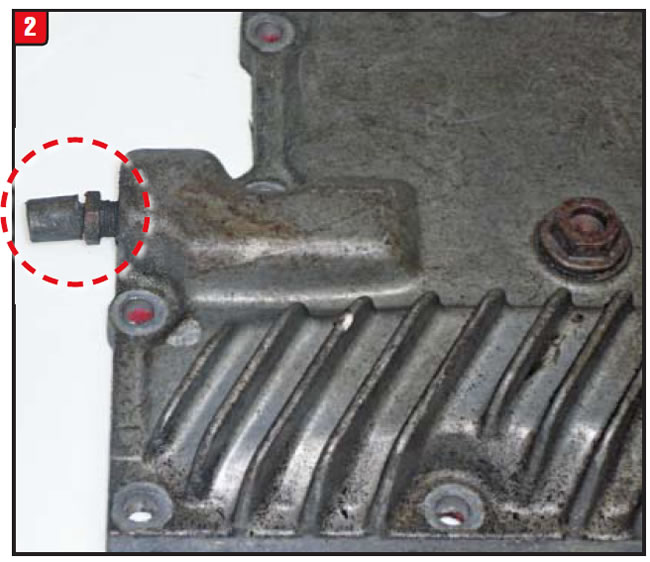
Even with 105,000 miles, the underneath of the truck was not in too bad of shape compared to other vehicles. There have been issues with certain years and models of Toyota trucks relating to frame sections and differential housings rusting. Certain models have had frame sections replaced under warranty; however, rusted differential assemblies have not. As a precaution, always closely examine the truck differentials for excessive rust, which can lead to holes and leaks. If a leaking differential oil level gets low enough, it could literally seize up driving down the road, which is bad news, so be aware.



There was a time that automatic transmissions did not even use solenoids for any function, but that was back in the good old days, supposedly. When the Turbo Hydramatic 300 and 400 were launched back in the 1960s, GM set the tone for what the transmission repair industry is dealing with today. The 300 and 400 transmissions used either one or two basic on-off check-ball-style solenoids that controlled a kick-down downshift or variable-pitch torque converter.
The solenoid wiring and case connectors were childʼs play. Throughout the late ʼ60s and ʼ70s, little change occurred, affecting transmission electrical. Even by the early ʼ80s and the release of the dreaded lockup torque converter, transmissions such as the TH125C, TH200C and TH350C with a lockup solenoid, were not too bad to handle. That all changed with the 700R4 in 1982.
700R4 solenoids:
Even with a life-cycle range from 1982 to 1992, the total tonnage of solenoid part numbers was unequaled, steadily approaching triple digits. The 700R4 solenoid itself had little difference over the years, whereas the harness and connectors were unending (Figure 3). There was such an array of different pressure and temperature switches and electrical case connectors that a graduate electrical engineer would have been hard-pressed to cope with. The changes made, required pages of electrical schematics, just to figure out what plugged in to what. The 2004R was not quite as bad.
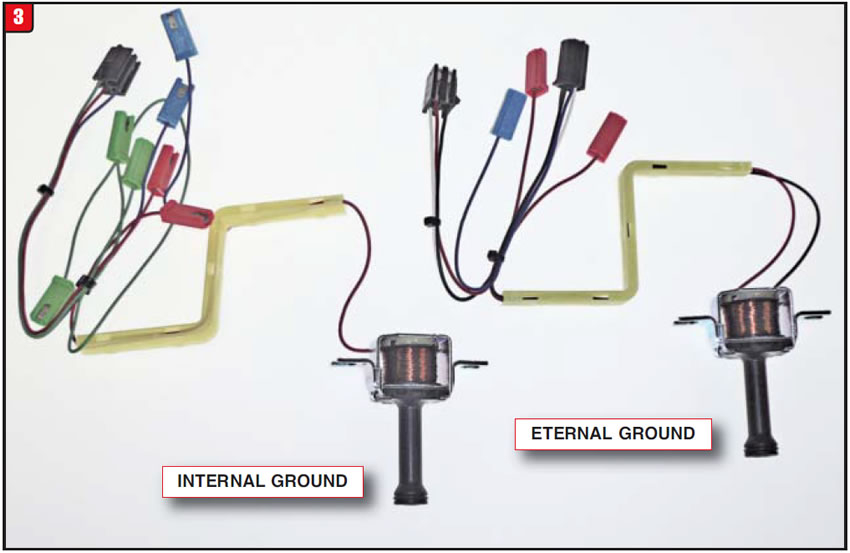
4L60E solenoids:
Although the 4L60E did not have quite the harness nightmare of the 700R4, it made up for chaos in other ways. The 4L60E has been a work in progress, by first not having a PWM TCC solenoid, but using a PWM solenoid for a 3-2 downshift. Then in 1994, GM added a PWM TCC solenoid, but later on in 1996 changed the 3-2 downshift solenoid to an on-off design, for what reason, who knows. These minor tweaks did require different harnesses.
The EPC solenoid remained unchanged, at least for a while; however, in 2003 a change in production occurred affecting the harness plug. To ensure better contact the previous spade terminals were changed to a molded connector with pins (Figure 4). The molded connector for the 4L60E is black and is on the side of the solenoid. Changes that occurred in 2006 with the addition of the ISS to the pump and in 2009 with the change of the external MLPS to an internal mode switch (IMS) resulted in more harness changes affecting the TCC solenoid in the pump.
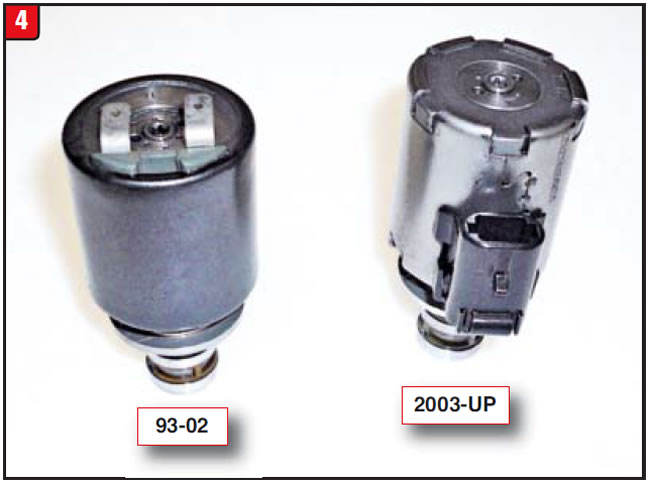
4L30E solenoids:
By the time the 4L30E hit the streets in 1990, a small European company called Bosch was starting to make inroads into the domestic transmission market, and even though the transmission was manufactured in Strasbourg, it was still a GM unit. Bosch was chosen to supply the EPC solenoid, which was a big silver body design. Initially, import car companies like Honda and Isuzu used the 4L30E; however, GM did not add it to the line until 1997. At that time, the decision was made to use a different design Bosch solenoid for GM that was actually the early 4L80E. In addition to OE production, a service package was released for all manufacturers to use that contained the 4L80E part and a special bracket. With the proper bracket the black body Holly 4L60E can also service ʼ90-ʼ99 models.
Things got even more convoluted in 2000 when the EPC solenoid was changed to the Ford 5R55E design (Figure 5a). As shown in the illustration all three solenoid designs require different hold-down brackets.
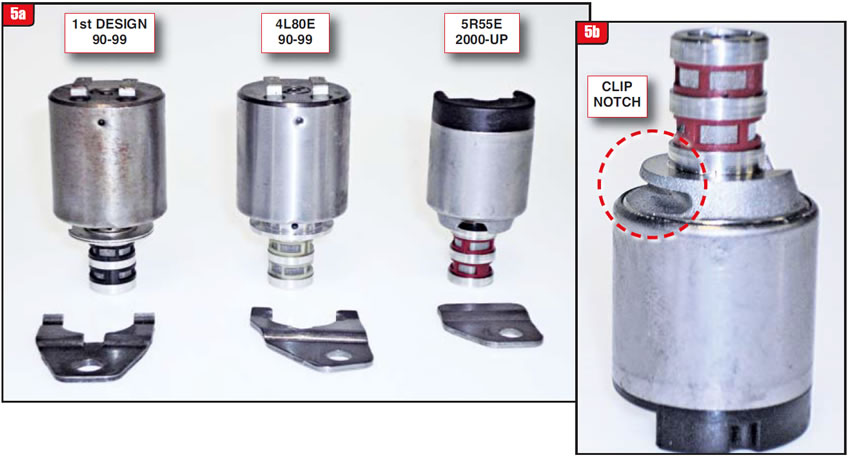
Whether Ford OE or aftermarket, make sure that the notch is there for the bracket (Figure 5b). Also in 2000, there was a change to the TCC solenoid when it was switched from a bolt-in design to a push-in, specifically the 4L80E TCC solenoid.
4L80E solenoids:
When the 4L80E was being developed, it was initially decided to use Bosch as supplier of the EPC solenoid. As a means of cutting costs and supporting domestic suppliers, GM decided in 1994 to switch over to the black body Holly design EPC, used in the 4L60E. The change of the solenoid design required the hold-down bracket to be changed as well (Figure 6).
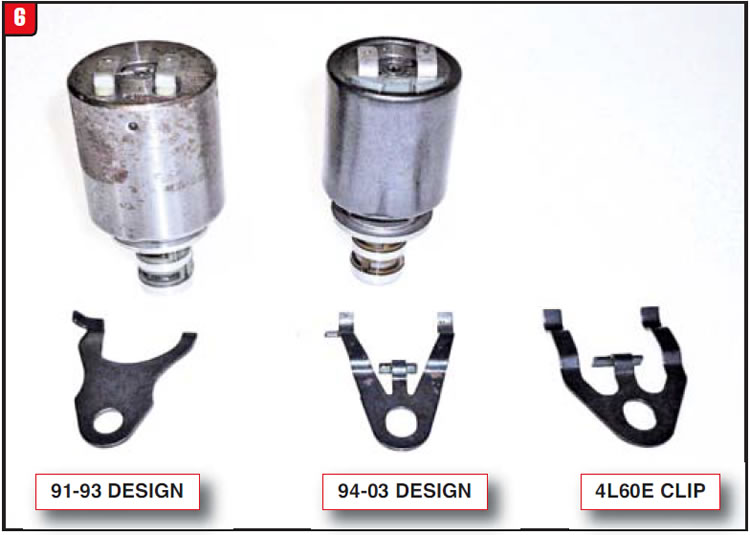
With the proper bracket, the Holly solenoid would retro back to 1991. Just as with the 4L60E, GM decided to change from the spade terminal design over to a molded connector in 2004. To differentiate between the 4L60E/4L80E solenoids, the 4L80E molded connector is white. Both solenoid models have a silver body like the early Bosch designs.
4T65E solenoids:
When the 4T65E was launched in 1997, solenoid layout was fairly straightforward with the shift, TCC and EPC solenoids being traditional in design. One glitch did surface for aftermarket repair concerning the TCC solenoid. On the surface, the TCC solenoid is the same type used in both the 4L60E and 4T65E (Figure 7). This is because they are the same, right down to the calibration spring; however, there is a difference and using the 4L60E in a 4T65E can cause lockup issues. The difference is how the manufacturer recesses the small soft plug in the end cap, which is the seat for the calibration spring. The position of the soft plug results in a given spring tension against the check ball affecting output pressure. Externally, the solenoids look identical with two exceptions. The part number that may be stamped into the body of the 4L60E is 24227792, whereas the stamp number for the 4T65E is 24227747. For identification purposes, the 4T65E may also have a spot of purple paint on the connector. The 4T65E works well in 4L60E models.
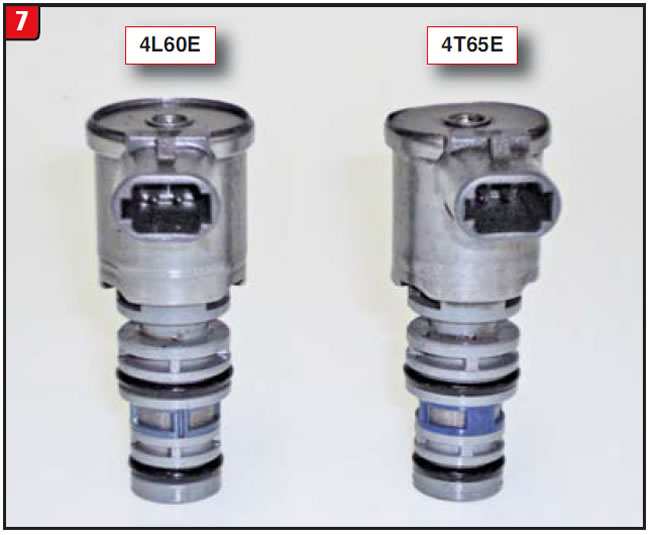
As a phase in during 2003, the EPC black-body Holly solenoid was changed to a small silver-body Bosch solenoid (Figure 8). The two solenoids are not interchangeable, so be sure of the design before ordering any replacement.
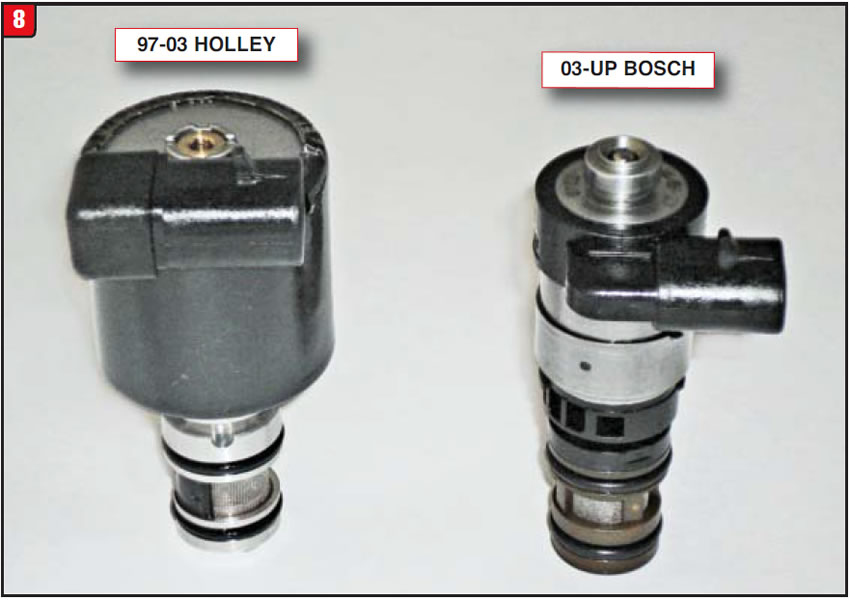
5L40E solenoids:
The other transmission to roll out of Strasbourg was the 5L40E five-speed automatic, which was an entirely new platform containing a lot of stuff. When it came to solenoids, however, GM did carry over the TCC and EPC from the 4T65E including the EPC changing to the Bosch design in 2004. The issue was the shift solenoids that are color-coded green (Figure 9). Although the shift solenoids are simple on-off and look identical to the 4L60E 1996-up white connector 3-2 downshift solenoid, there is a slight difference in resistance. Although it will fit, use the correct green connector design on 5L40E units.
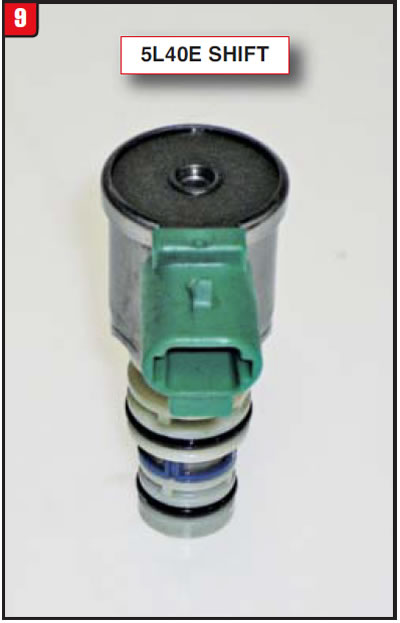
6 Speeds:
Solenoids for the newer GM six-speed transmissions are encased in a big chunk of plastic (TEHCM assembly), making it virtually impossible for a shop to change individual solenoids. With the proper testing equipment, however, individual solenoids can be air tested, which is a plus. Not to be outdone by GM, Ford has also provided several wonderful solenoid scenarios to the repair industry. By the mid-1980s, a couple of transmissions were launched containing solenoids, such as the A4LD (TCC and 3-4 shift) and AXOD (TCC), all of which were simple on-off designs. By the early ʼ90s however, things started to change.
AX4S/AX4N solenoids:
Although the AX4S and AX4N are substantially different transmissions, the electrical aspect is similar. For instance, even though there are two EPC part numbers between the two transmissions, only the hold-down brackets are different; the solenoid itself is the same.
The TCC solenoid, used in the 1991 AX4S (AXODE), was unique and only used for one year; however, beginning in 1992-up applications, the TCC solenoid was changed to a PWM design. The problem was, based upon year and vehicle model, the TCC solenoid could be one having a low resistance (white connector) or high resistance (blue connector). Using the wrong solenoid would definitely create problems.
The shift solenoid difference had nothing to do with resistance, but rather the solenoid having a diode or not. AX4S transmissions basically used a shift solenoid that had a diode and the connector color was black, whereas AX4N solenoids did not use a diode and the connector was white (Figure 10). A black connector shift solenoid can be used for all models, but using a non-diode white connector solenoid in an application that requires a diode will most certainly zap the ECM.

4R44E/5R55E solenoids:
The electronic transmission replacement for the A4LD hit the streets in 1995, initially as a four speed (4R44E, 4R55E). Solenoids controlled every aspect of the transmission, such as the line pressure, shifting and lockup. The solenoids were provided by Bosch. As a so-called improvement, a change to the solenoids occurred in 1997 with the launch of the 5R44E/5R55E five-speed models. A feature was added to the solenoids referred to as inductive signature, which is an electronic footprint that can tell the computer when something is amiss. There is a noticeable difference in appearance between the designs, especially the EPC solenoid (Figure 11). The upside is, the solenoids with inductive signature can retro back to 1995 and are less costly. Do not, however, use the early design in ʼ97-up vehicles. The newer version five-speed transmissions released in 1999 (5R55N, 5R55S) use a solenoid block assembly that makes individual solenoid replacement impossible, resulting in increased repair cost.
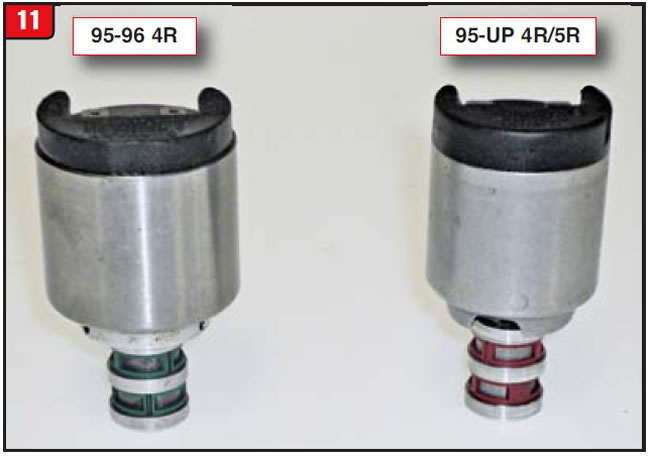
4R70W solenoids:
When the AODE/4R70W families of transmissions were released in 1992, the harness assembly used was a soft-wire (loose) design; however, by 1998 Ford decided to go with a circuit board and changed to a hardwire design. For some reason, that mindset was changed in 2009 when the transmission harness was switched back to soft wire.
As if that wasnʼt bad enough, the EPC solenoid seemed to go through unending changes as well, going from a soft wire, then hardwire, then soft-wire style connector. Beyond that was the array of electrical connector colors and hold-down bracket designs (Figure 12). On the OE side, beginning with the hard-wire type in 1998, the connector color was green, then went to tan or blue in 2001 and then to a black connector in 2005, continuing with black for the soft-wire design in 2009. On the aftermarket side, BorgWarner released more colors along with a silver body, unlike the OE black body design. The BW connector color for 1998-2000 is red with the 2001-04 application being a mustard color. The issue is, for 2005-08 solenoids BW chose to use a tan connector, like the OE 2001-04 tan connector design, which will not work. As a fix, BW has added a blue dot to the tan connector, so look for it.
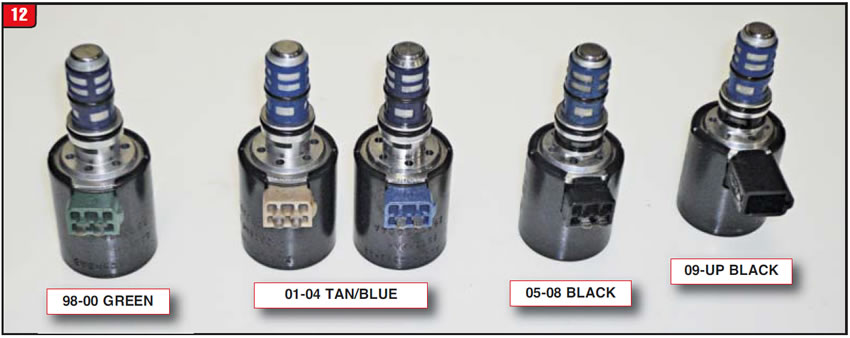
5R110W solenoids:
What appears to be the valve body on a 5R110W transmission is really nothing more than a solenoid body that contains seven solenoids. There are three different styles of solenoids and fortunately all have locating tabs to prevent any mix up. Early on, there was an issue with the EPC solenoid that required an upgrade. The early EPC solenoid had a stamp number of 3C3P, which should always be replaced by the new stamp number 4C3P design. Beyond that, always check each solenoid closely to make sure that the body and barrel fit tightly, since they can loosen over time.
6R60/6R80 solenoids:
Ford basically followed the ZF 6HP design when developing the 6R60 family of transmissions, with certain exceptions, such as electrical. Although the solenoid arrangement is comparable between Ford and ZF, the solenoids themselves are not, although Ford initially used Bosch as a supplier. Terminology also varies when describing each type of solenoid. For instance, Ford may use the term low or high variable bleed, whereas ZF may use normally vented or normally applied. Replace all original solenoids with the exact color type.
There are three basic types of solenoids used, three NL (normally low/brown color), three NH (normally high/black color) and one on-off that Ford uses. ZF early model 6HP units had three yellow (NL-NV) and three blue (NH-NA) as well as one on-off; however, later models may use different colors. In 2006, when the 6R60 was released, the PWM solenoids used a brown or black cap (Figure 13). The two designs cannot be interchanged.
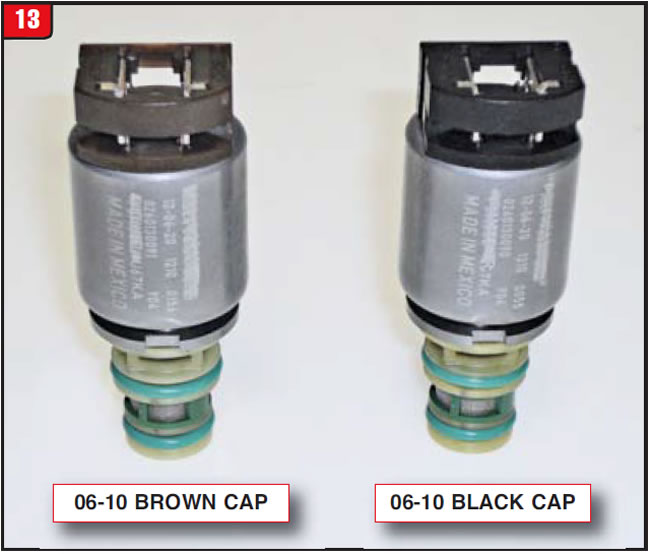
In 2010 when Ford started to phase out mechatronics (internal TCM), the solenoid supplier was changed from Bosch to another company as well as the design. The new design solenoids all have a neutral color (white) cap and the barrel of the solenoid is colored brown or black (Figure 14).
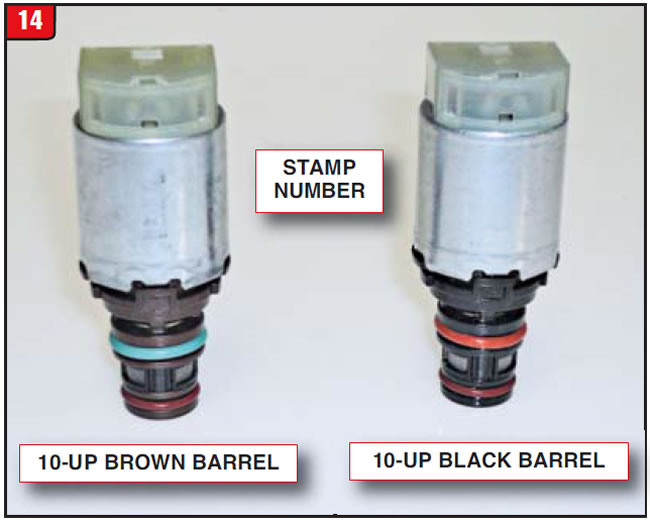
In addition to the basic design differences is another wrinkle, calibration. The new design PWM solenoids now have a stamp band number on the body to denote a pressure setting. Standard practice dictates replacing the original solenoid with one having the same stamp number or drivability issues could surface. The OE part number and stamp number is as follows:
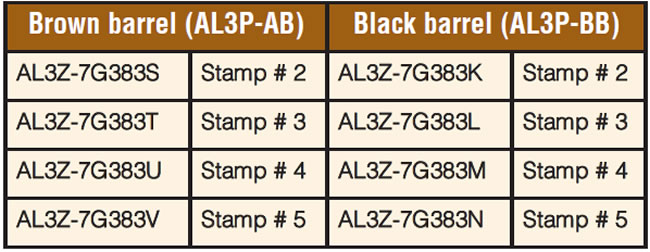
6R140 solenoids:
The approach to solenoid operation ramped up even further with the launch of the 6R140 transmission in 2011. As with late-model 6R80 applications, solenoids used in the 6R140 have several different part numbers based upon overlapping pressure parameters. When replacing an individual solenoid, the solenoid style (normally low/normally high) and stamp number (pressure range) must conform to what is being replaced. If a major component such as the valve body or entire transmission is to be replaced, additional steps must be taken. There are identification tags on the outside of the transmission case as well as the valve body to denote not only the valve body ID number, but the solenoid strategy as well. When the valve body or transmission is replaced the new identification and strategy information must be downloaded into the vehicleʼs computer or problems will arise. Using the solenoid information from the 6R80 section, merely substitute the AL3Z prefix with a BC3Z prefix to obtain the 6R140 solenoid needed.
Chrysler:
Although Chrysler lagged behind GM and Ford with electrical stuff initially, they have been catching up in recent years. RWD applications were pretty basic even with RE transmissions using an electronic governor. However, Chrysler was the first car company to launch a transmission with adaptive learn, the A604. The A604 did not initially have line pressure control, but that issue was rectified in 2006 with the addition of the VLP solenoid system in the 42RLEVLP and 41TES in 2007. With the addition of the ZF designed 8HP rear-wheel-drive and 9HP front-wheel-drive transmissions, Chrysler has absolutely stepped up to the plate.
Imports:
Over the years, car companies from over-seas have taken a similar approach to domestic manufacturers, starting with simple on-off solenoids with limited functions to an explosion of sophisticated PWM (linear, etc.) solenoids within a given transmission. It seems as though transmissions with more gears require much better strategy and control.
It remains to be seen how much more manufacturers can fine tune an individual solenoid, but itʼs inevitable that theyʼll keep trying regardless of external controls and strategies, therefore itʼs important to try to keep up.


December 2015 Issue
Volume 32, No. 12
- Toyota Tacoma Rear Differential Issue
- Transmission Solenoid Progression

